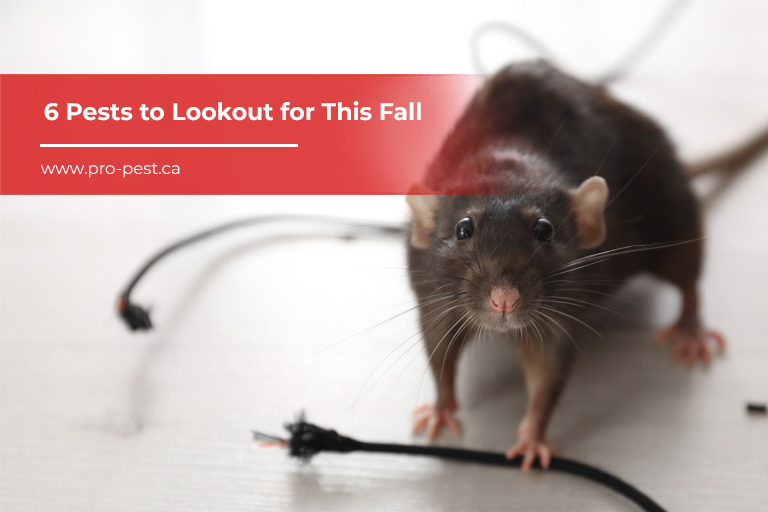As the summer comes to a close and we switch from gardening and grilling to baking and fireplaces, we must remember that we are not the only ones seeking shelter indoors in the coming months. Two things will follow during the fall: colder weather and the prevalent nuisance of overwintering insects!
In this blog post, we will discuss the most dangerous fall pests in Canada. These pests can cause significant damage to your home or place of business, so you must know how to identify them and protect yourself from them. Read on to avoid danger and pests this fall!
What Is Overwintering?
Overwintering is a term used for various organisms, including insects, birds, and vegetation, that adopt certain behaviours that enable them to survive in cold temperatures. Insects survive the winter by finding a warm place to tide them over the cold season. Often, this refers to a cozy human home. Insects penetrate structures, mulch, leaves, and soil to avoid cold temperatures. You can expect to find them in various parts of your property.
Insects consider your home as a “winter vacation spot.” Occasionally, during the overwintering period, they will enter residential areas to make themselves known. However, they typically emerge in the spring when temperatures begin to rise. This is a significant reason why there are so many more pests in and around your residence in the spring. They’ve been hiding there all along but just weren’t very active.
Common Fall Invaders
These pests have the potential to become a significant pest control problem. Here are some pests you need to watch out for during the fall and how to avoid them:
- Cockroaches

As the temperature outside drops, cockroaches seek the warmth and safety of human homes to survive the winter. Once inside a structure, cockroaches will scavenge for nearly anything, create an unpleasant environment, and transfer harmful bacteria to humans.
To prevent cockroach infestation:
- Maintain a regular cleaning routine and vacuum.
- Put food in containers that have a good, secure seal.
- Ensure that the cupboards are kept dry.
- Fill up all of the cracks and holes in the walls and floors.
- Repair any broken faucets or fractures in the plumbing, and invest in a dehumidifier to reduce the amount of moisture in the air.
- Rodents
In Canada, rodents are a prevalent type of pest. These rodents are drawn to residential and commercial areas for food and shelter. They chew on wires and insulation; rodents can cause significant damage and transmit disease.
To prevent rodents from invading your home:
- Keep doors shut and caulk around windows and doors to prevent intrusion.
- Look for openings in the siding, foundation, roof, and soffit. As necessary, make repairs to prevent rodents from entering.
- Routinely inspect exterior walls for cracks and gaps.
- Cover dryer vents, attic vents, and soffits with metal screening with a fine lattice.
- Eliminate nesting and harborage sites near your residence.
- Garbage should be kept in tight-fitting containers.
- Never compost fatty or oily food refuse, eggs, or dairy products.
- Eliminate water sources such as leaking faucets, sweating pipelines, and open drains.
- Maintain a tidy kitchen and store food and pet food in metal or glass containers.
- Store nonperishable items in plastic containers with airtight seals.
- Contact a pest control company that offers professional rat and mice control services
- Earwigs
In the fall, garbage, residue, piles of leaves, vegetation, and mulch attract earwigs. Furthermore, damp, dark basements with numerous foundation cracks provide optimal hiding places for these pests.
To prevent an earwig infestation:
- Remove all decaying vegetation from around your home.
- Remove piles of leaves, grass debris, and compost.
- Fix any leaking downspouts, reroute clogged drains, and fix malfunctioning irrigation systems.
- Cluster Flies
Cluster flies proliferate in fields and lawns during the spring and summer. Cluster flies are not interested in human food, refuse, feces, animal carcasses, livestock, or manure. Instead, they feed on flower nectar. As winter approaches, cluster flies infiltrate houses, searching for a place to hibernate. These pests are particularly drawn to west and south-facing buildings, which receive more sunlight. They do not pose a threat to humans and do not reproduce in the homes they occupy, but they are viewed as a nuisance due to their tendency to hibernate in large groups.
How to get rid of cluster flies:
- Caulk exterior gaps and crevices around windows, doors, eaves, roofs, siding, utility pipes, behind chimneys, and other entry points.
- Install window and door screens.
- Install insect screening or mosquito netting over soffit air vents.
- Asian Lady Beetles

The Asian lady beetle is a native pest of Asia, where it lives in trees, fields, and plantations and feeds on aphids and scale insects. They were introduced to North America in the 1970s to control crop pests. These insects are commonly referred to as “ladybugs“.
While ladybugs are generally considered beneficial because they live and feed on plant pests outdoors, the Asian Lady Beetle is an aggressive pest and a nuisance to other crops and people. As the fall weather comes, they seek warmth and shelter in adjacent cracks, crevices, and gaps, entering homes and businesses. Once inside, they gather in attics and wall gaps, which are silent and secure, and hibernate until spring.
How to get rid of the Asian Lady Beetle effectively:
- Use good silicone or silicone-latex glue to seal small cracks, crevices, gaps, and holes outside your home.
- Window and door screens must be fixed, replaced, or put in.
- Fix, repair, or put new screens behind your attic vents.
- Roof and soffit vents must be fixed, replaced, or given screens.
- Replace weather stripping that is broken or missing around doors.
- Put door sweeps on the outside of your doors.
- Boxelder Bugs
During the warm months, boxelder bugs live on boxelder, ash, and maple trees with seeds. They eat seeds, fresh twigs, flowers, and leaves. In the spring, these host trees are also where they lay their eggs and breed.
Many gather on the south sides of trees, rocks, and buildings late in August to take advantage of the warm late summer sun. As the weather gets cooler, especially in the evening, they look for warm, safe places to spend the winter. Boxelder bugs enter homes through tiny cracks and gaps, resulting in attics and wall cavities.
How to get rid of boxelder bugs:
- Fix broken window and door screens with holes.
- Put screens in the roof and soffit vents or fix the ones there.
- Put door sweeps on the outside of your doors.
The fall season is back, so it’s time to be extra careful about any pests in your house. If you have trouble getting rid of pesky creepy crawlies in your home, contact Pro Pest’s animal and pest control services. Call us today at 416-487-4179 for reliable pest control and animal removal services in Toronto.


















